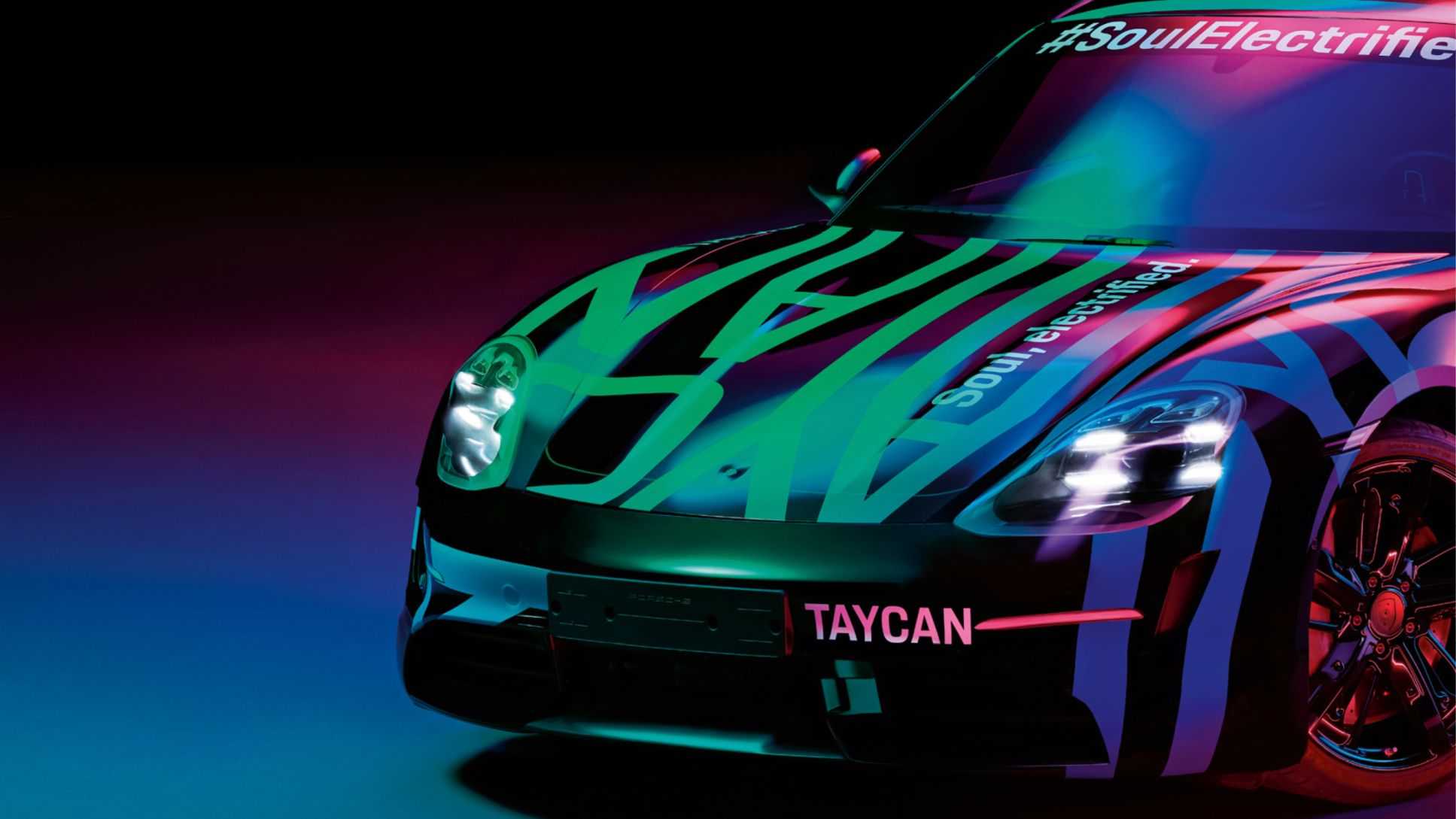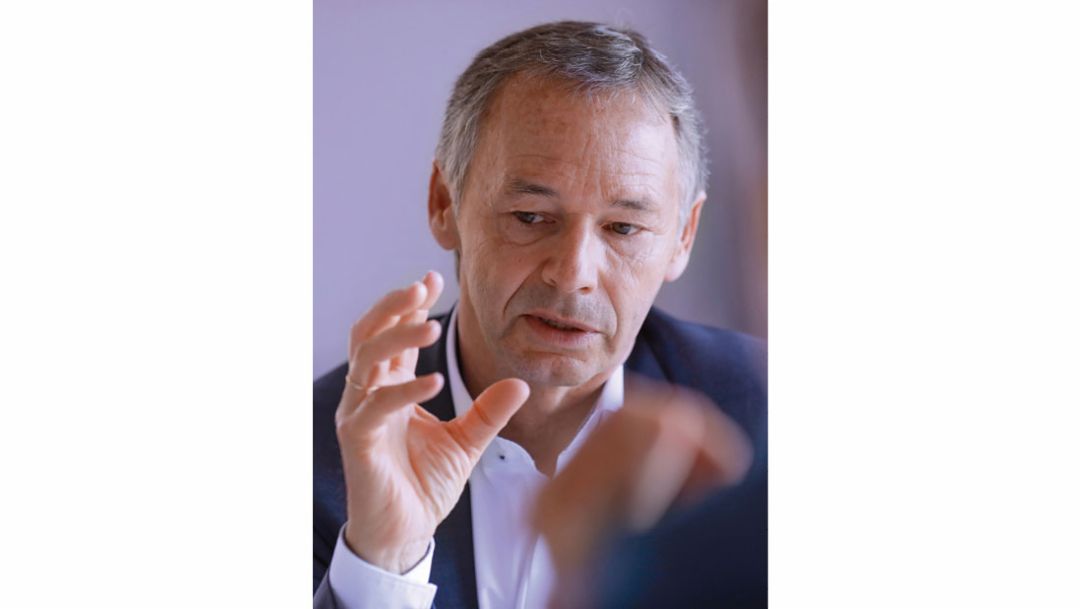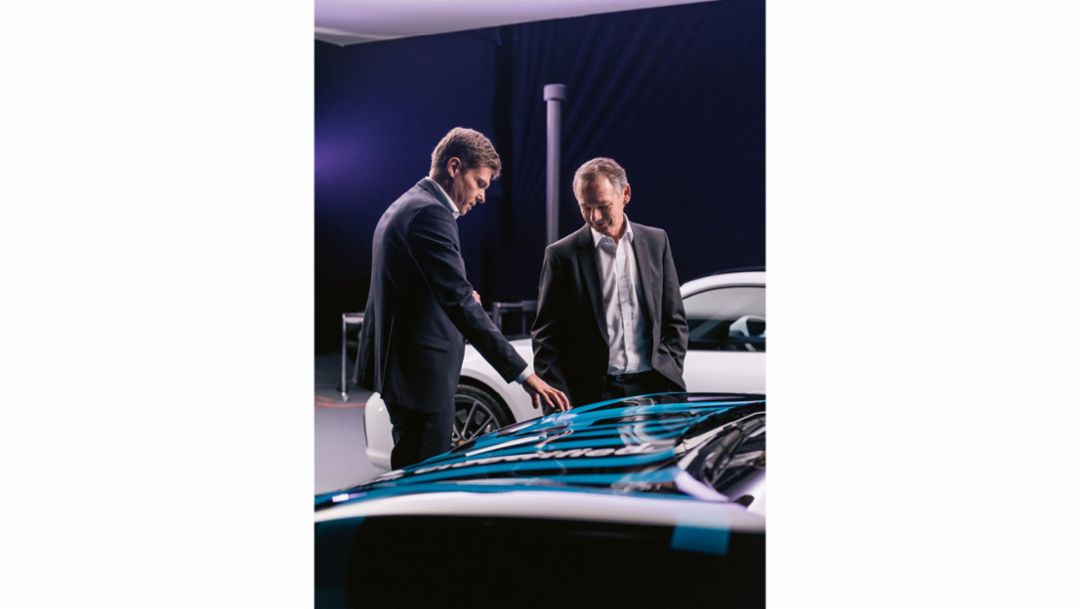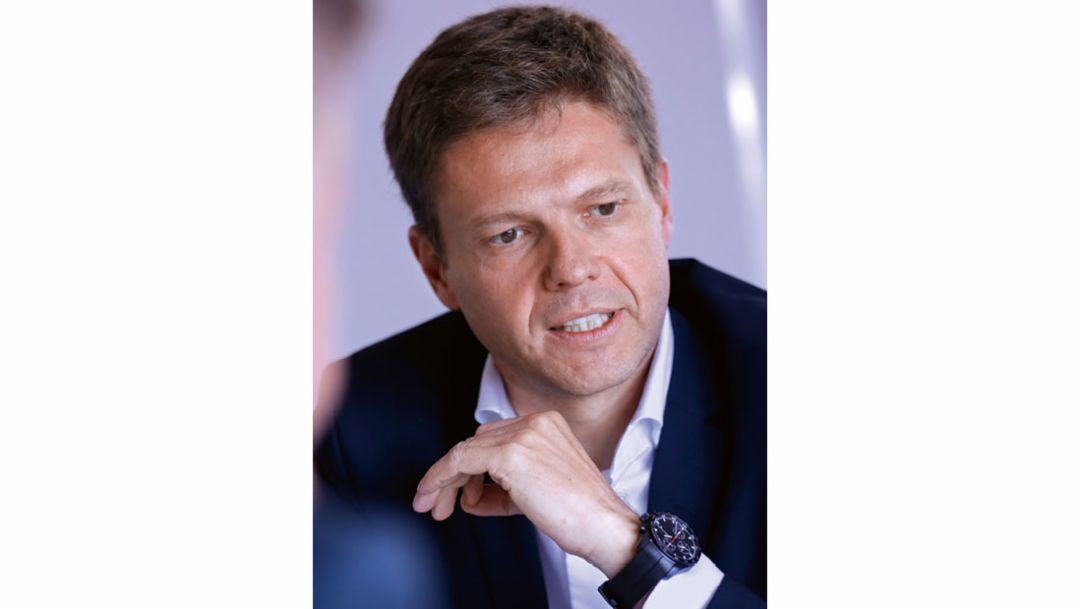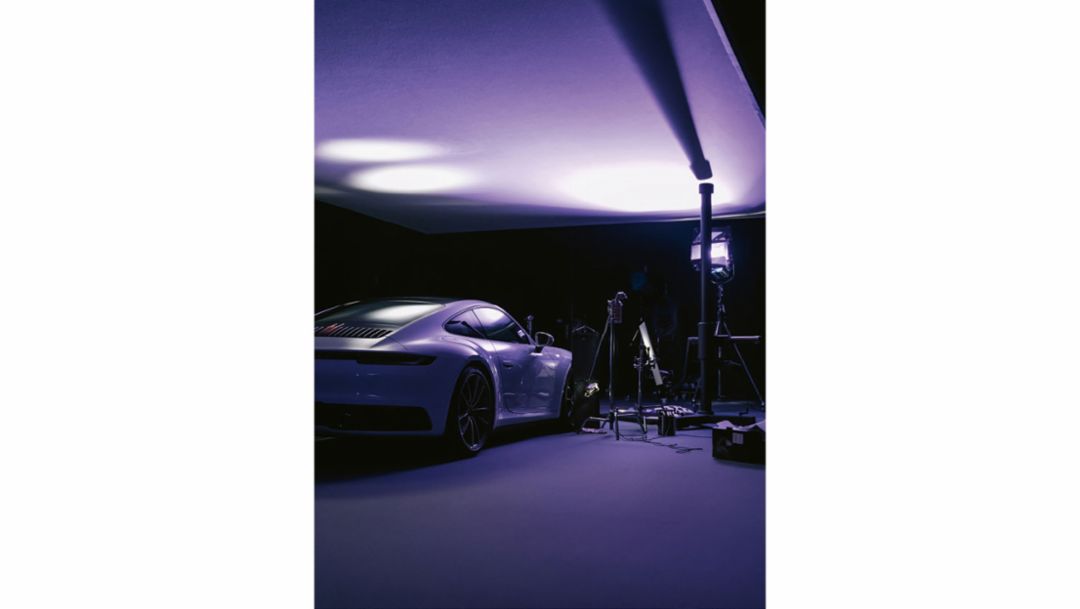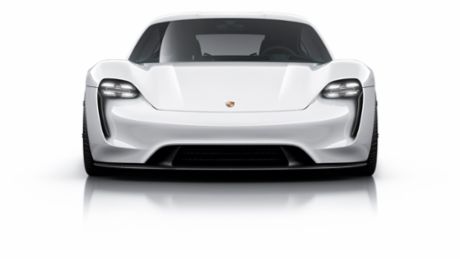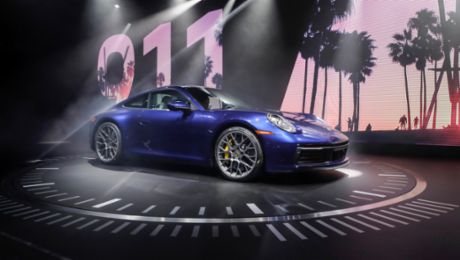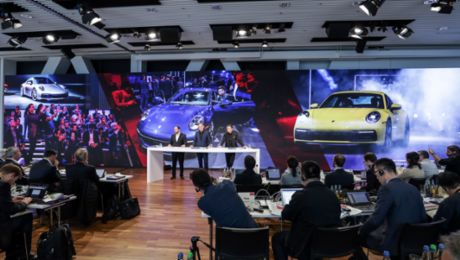It is a warm early afternoon, around 1 pm, in an inconspicuous hall in an industrial zone on the edge of Stuttgart. The windows of the building are completely covered up, the gates are carefully locked so that nobody can look in or come in without authorisation and nothing is leaked to the outside. Inside is a bewilderingly camouflaged test model of the Taycan. In 70 years of sports car history, it is the first purely battery-powered Porsche from Zuffenhausen. At this point, only rough outlines are known about; the trade journals are outdoing each other with more or less futuristic phantom images, but one thing is clear: the Taycan will enter a completely new dimension of the Porsche brand, which traditionally draws its power from high-performance combustion engines. A quantum leap. And, like any radical change, not without risk.
Right next to it, in the dark, the new Porsche 911 is parked – the classic which, since its première in 1963, has been engraved in the collective conciousness, whether as the absolute core, synonym or heart of the Porsche brand. A myth, with more than a million cars built, a phenomenon of contemporary, cultural, technology and design history, an automobile which is constantly new and yet so provokingly unchanged. Two worlds collide – but they have a single origin. And a common goal: to define what Porsche is in a new way. What the brand stands for. And what it means to the two men who are now circling the vehicles, busy in discussion.
August Achleitner, a lean, rather boyish-looking 63-year-old, is more or less the brain of the 911. The automotive engineer has been head of the model line for 18 years; the eighth generation of the 911 will be his last. He has constantly preserved this inheritance by carefully developing it in line with the Porsche values of tradition and innovation: transition yes, radical change no. He has shaped the 911 as few others have done, although he would scarcely admit it. If you mention his role to him, his answers quickly meander towards “my team” or “my people". "The development of the 911 is always an evolution, never a revolution", he says. "At the same time, we have created each new generation in such a way that it will not devalue its predecessors. This explains why Porsches are so timeless."
Stefan Weckbach, a good 20 years younger than his counterpart, oversees one of the most demanding tasks which Porsche currently
has to offer. With a degree in business administration, he used to be head of the model line for the Boxster, and is now in the same function as the man behind the Taycan, a revolutionary vehicle concept with a completely new plant at the headquarters in Zuffenhausen. An additional 1,500 employees are being hired here and, in the course of the electric mobility campaign, around six billion euros will be invested. A future pact by the staff and plant management enables this feat of strength. Together, they are sending out a strong signal: the radical new Porsche – due to be presented at the end of 2019 – will be produced at the birthplace of the brand. In pointing the way to the future, it will return to its roots. Weckbach’s mission is to prove that the effort is worth it, that the brand can, at the same time, renew itself and remain true to itself. “As the first fully electrical Porsche, the Taycan has to show that it is a fully-fledged member of the Porsche brand,” he says. “Of course, this is a great challenge – and a huge expectation, both internally and externally.”
Another reason expectations are so high is that the Taycan is to be nothing less than the pioneer of a whole series of partially or fully electrical Porsche models which will come onto the market in the next few years. According to Porsche’s plans, more than 50 % of the new vehicles sold are to have an electrical drive as early as 2025 – which is practically the day after tomorrow. Whether this will really come about will very much depend on how the Taycan and, soon afterwards, its derivative, the Cross Turismo, a lifestyle-orientated variant with a higher utility, will prove themselves on the roads and on the market. The brand must, therefore, shed its skin and remain true to itself at the same time. It has to keep its fans excited and simultaneously gain new customers who may have no idea today that they will decide to buy a Porsche tomorrow. The brand must do one thing with out losing track of the other. To put it in driving terms, it must keep in its lane and pull out at the same time – at high speed.
How can such a manoeuvre be carried out without being torn apart by centrifugal forces? For August Achleitner, a substantial part of the answer lies in the new 911. With Weckbach, he is discussing the many large and small innovations which they have built into the latest 911, while at the same time protecting it against too great a desire to change. “Like the previous ones, this 911 does not dare to question its own legendary status,” in the words of an independent motor journalist. “No noise protection law in the world can silence the striking raspy voice of the artificially ventilated 3.0-litre six-cylinder flat engine; the typical coasting rattle has prevailed over the decades just as has the high-revving roistering; the combination of Sport Plus driving programme and activated sport exhaust bring the plaster crumbling from the ceiling of dilapidated tunnels when at full throttle and in low gear.”
In other words: despite all the innovations, the new 911 is the same as the old one too. Everything remains new. Is it, therefore, the best 911 of all time? “Of course,” Achleitner replies without hesitation. “It is, just as every generation before it has been the best to date. But we have a lot of creative engineers, designers and other clever people on board, who will be sure to have ideas this time, aswell, about what could be done even better for the next generation.”
Most telling, however, is which of their numerous ideas Achleitner and his team did not implement in the course of the model over haul, which took place without market research meetings or product clinics and solely by trusting their instincts. "We have a very special team at Porsche who are, themselves, the greatest fans of our vehicles", Stefan Weckbach interjects. "They know exactly what is right and will bring us forward."“Every now and then, people from outside say that we have to be careful not to lose our DNA,” says Achleitner. “I don’t see any danger of that.” That’s because the brand’s gene
pool is in the people who plan, think, build and live the Porsche. And like any genetic material, the formative features change a bit more with every evolutionary step. And, at the same time, remain true to themselves by permanently changing.
For some people, this transformation conjures up an almost magical effect. Wolfgang Porsche, for example, talks of the “magic of Porsche”, which must be retained. The grandson of Ferdinand Porsche and Chair of the Supervisory Board of Porsche AG reminds us that, today, not a single part of the 911 is identical with its counterpart from the 1960s – and yet, the essential core of the sports car icon has remained the same for more than 50 years. “That’s because it is not the technical details that constitute the identity of a 911,” he explains. “The decisive factor is that a thing remains true to its own essence. And I don’t know of any car which has remained so unchanged in its essence, despite all the technological and Zeitgeist-related changes, as the 911.”
Those moments at which the 911 did experience extensive innovations proved how flexible and, at the same time, how robust the Porsche brand philosophy actually is. The change from air to water cooling, for example, or the decision in favour of the turbo, were bound to cause gasps among hardcore fans. At least initially. Because, just as surely, each revised model also eclipsed the sales figures of its predecessors – thus disproving those doubters who had already thought the classic vehicle was going astray. “Our people live and love Porsche,” says Achleitner. “For them, their work is more than just a job. This means that, in reality, they themselves are the most careful preservers of the Porsche gene.”
A different case but with a similar effect: the newly introduced model lines Cayenne, Panamera or Macan also each ensured a greater acceptance of the established model lines. What seems paradoxical at first glance is, at second glance, proof that the “preservers of the Porsche gene”, as August Achleitner calls them, very clearly possess some skill in sustaining the core of their brand by constantly renewing both its substance and its manifestations. Another example of this is the Taycan.
If you believe Stefan Weckbach, the newest addition to the Porsche family stands neither for radical disruption nor for a new beginning. Rather, the first fully electrical Porsche is simply “the next logical step”: not simply another electrified premium vehicle, but undoubtedly a Porsche, even if it will be more digital, and of course more electric, than any Porsche before it. Of course, there are certainly some sporty e-cars on the market which started off accelerating impressively, only to reach their performance limitations, says Weckbach. “That wouldn’t be enough for us. A Porsche must offer reproducible performance, which means that it has to offer the highest performance at a constant level.”
Weckbach tells of how his developer colleagues are working under pressure to adjust many apparently smaller, some larger and, above all, decisive last screws in order to achieve this goal with their usual precision. On intelligent cooling systems, for example, on the elements of the innovative 800-volt technology and many other things with which they are installing maximum performance, large range, short charging cycles and Porsche’s typical driving dynamics into the Taycan. The aspiration of never standing still and never being content with what has been achieved, but rather of leading the field with extraordinary achievements, even if this often demands an exceptional commitment: this, too, is typical of Porsche.
For example, the decision to equip a Porsche with a purely electrical drive after seven decades of the combustion engine did not provoke the slightest resistance within the company, says Achleitner. “On the contrary, a self-confident attitude prevailed: let’s show them that we, too, can make a fully electrical sports car. Something that has never existed before – just as when we made the first sporty SUV a few years ago with the Porsche Cayenne.” To focus primarily on the drive type, in Achleitner’s opinion, falls short in any case. To be more precise, it snags, so to speak, in the engine compartment. For Porsche, the drive system is only a part of the whole. And very different things are decisive for this whole. Achleitner then tells of how he got behind the wheel of one of the first Taycan prototypes for the first time. How he adjusted the seat and the steering column, scrutinised the digital dashboard and felt the “basic ergonomics” of the vehicle. How he then closed his eyes and thought: “It fits! A genuine Porsche.”
But what is a genuine Porsche, exactly? What can, may, or must submit to evolutionary change? Which of the brand’s features are unchangeable? There is the sporty flyline, the flared hip, the contour of the windows, the four-point daytime driving lights and the slender head on broad shoulders: all of these mean that a Porsche is already identified long before its engine sound can be heard. For Stefan Weckbach, other parameters apart from this are also characteristic of Porsche: driving dynamics, emotion, quality and performance, for example. “What characterises a purebred Porsche is the fact that it always actively involves its driver,” Achleitner elaborates. “And this philosophy is contained in the Taycan, just as much as in the 911. The adjustment period from one vehicle to the next takes a few minutes. If even that.”
Seen in this way, both Porsche models are pretty much built along the same ideal line with which the brand is being continued. Each stands for an autonomous, unmistakeable personality. And yet they are obviously similar in many essential respects. In this sense, they resemble the two model line heads, who are now slowly strolling towards the hall exit. Even though they belong to different generations, the two men have a surprising amount in common. Both spend as much time as they can on two wheels in their spare time: Achleitner also on a motorbike on occasion, and Weckbach always in the saddle of his mountain bike. They both work in the development centre at Weissach, only a single floor apart, and exchange views whenever necessary, quickly and at the drop of a hat.
Weckbach tells how, very soon after he had started working for Porsche, he acquired a 997 Carrera S as a leasing vehicle. How, when he had to return the car with great regret, his father bought it for him. “The best thing is that the car is still standing in his garage.” Achleitner’s Porsche initiation happened even longer ago, in his youth. At that time, the programme Blickpunkt Sport on Bavarian Television was accompanying the racing driver Walter Röhrl in his preparation for the 24 Hours of Le Mans: “on the Porsche test track in Weissach,” as Achleitner recalls. The images of the dynamic car and its driver never left him after that. Born in Munich and the son of a BMW head of department, this finally led to him to make his way to Stuttgart and Porsche as a young automotive engineer in the 1980s.
As a developer, he then experienced how the Porsche product family developed in a way that many people would never have thought possible. How, among others, an SUV, a Gran Turismo and a compact SUV supplemented the family and extended its fan community. How the brand caught on not in spite of, but because of its ability to transform. Achleitner’s heart is still set on the 911 after all this time: “This car that is really irrational and yet enormously suitable for everyday use,” as he calls it. Therefore, there will always be a 911 parked in his garage. When the two men finally leave the hall and go to their vehicles, he adds: “But in future, I could also imagine owning a Taycan.”
Info
Author: Harald Willenbrock
Text first published in the Porsche Annual and Sustainability Report 2018.
